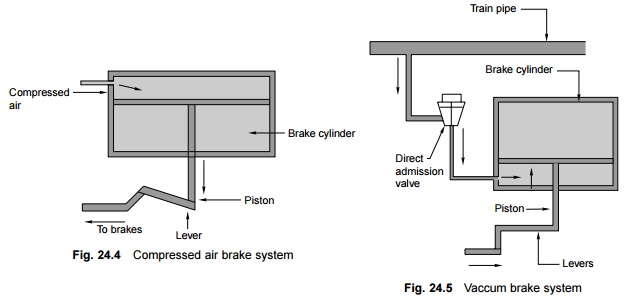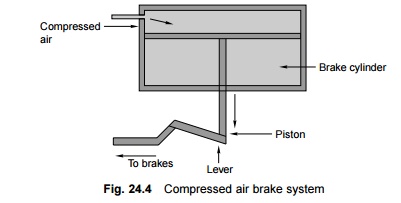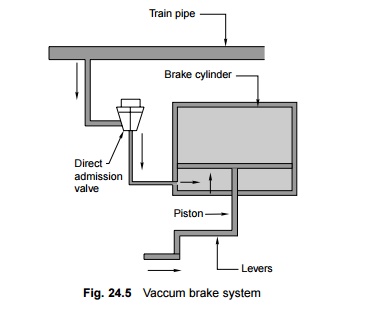Chapter: Civil : Railway Airport Harbour Engineering : Railway Engineering : Locomotives and Other Rolling Stock
Rail Brake Systems

Brake Systems
Brakes in the locomotive are
applied to stop a moving train. There are basically two types of brakes.
Compressed air brakes
This brake system is made up of a brake cylinder containing a
piston and lever arrangement, which is provided under each vehicle. A brake
pipe running is also provided under each vehicle, which extends from the main
reservoir to the locomotive. The reservoir is provided in that part of the
locomotive where compressed air is fed in through the air pump (Fig. 24.4).
When compressed air is admitted into the system, the movement of the piston
results in the application of the brakes.

Vacuum brakes
The equipment consists of a vacuum brake cylinder with a
piston and lever arrangement provided under each vehicle. The cylinder is
connected to the train pipe running from one end of the vehicle to the other. A
direct admission valve provided with each coach is also used for applying
brakes in the case of an emergency. A vacuum of about 20 inches of mercury is
maintained in the vacuum cylinder on one side of the piston in order to operate
the brake system. This vaccum exerts an effective working pressure of about 10
psi on the piston when the brakes are applied. The vacuum cylinders are
designed to supply the required amount of brake power at the wheels by making
use of this vacuum (Fig. 24.5).

1 Vacuum Brakes Versus Air Brakes
It has become necessary to run
longer, heavier, and faster trains on account of the constant increase in
traffic on the Railways. Therefore, whereas the prevalent automatic vacuum
brake system is continuously being improved, the feasibility of using air
brakes is also being explored. The fundamental considerations which govern the
performance of a railway braking system are summarized here.
(a) The fast
propagation of air along the entire train length to ensure the uniform
application of brakes.
(b) A very
rapid initial filling up of the cylinder so that the brake blocks are quickly
brought in contact with the wheel to start the process of deceleration.
(c) A slower
subsequent filling up of the cylinders to allow a gradual retardation of the
wagons.
(d) A fast
release of brakes throughout the train length so that trains can restart
quickly
after having come to a stop.
The air brake system claims superiority
over the existing vacuum brake system in all these spheres. However, air brake
system has a few comparative disadvantages, which are as follows.
(a) A long
train gives a sluggish response to the control of the driver, as the time
required for the compressed air to reach the last vehicle is considerable.
(b) If for some reason the train gets divided into two parts, the front portion of the train gets receives the power to operate the air brakes whereas the rear portion does not receive it. This can result in an accident.
Related Topics